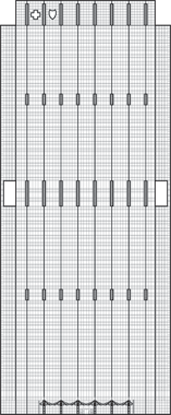Filter by
This project is a renovation and replaced Blue Cross-Blue Shield Headquarters
You must be a CTBUH Member to view this resource.

Blue Cross-Blue Shield Tower
Building
Completed
2010
Office
Concrete-Steel Composite
226.7 m / 744 ft
54
3
39
217,756 m² / 2,343,906 ft²
You must be a CTBUH Member to view this resource.
You must be a CTBUH Member to view this resource.
Construction Start
Completed
Usually involved in the front end design, with a "typical" condition being that of a leadership role through either Schematic Design or Design Development, and then a monitoring role through the CD and CA phases.
The Design Engineer is usually involved in the front end design, typically taking the leadership role in the Schematic Design and Design Development, and then a monitoring role through the CD and CA phases.
The Design Engineer is usually involved in the front end design, typically taking the leadership role in the Schematic Design and Design Development, and then a monitoring role through the CD and CA phases.
Other Consultant refers to other organizations which provided significant consultation services for a building project (e.g. wind consultants, environmental consultants, fire and life safety consultants, etc).
These are firms that consult on the design of a building's façade. May often be referred to as "Cladding," "Envelope," "Exterior Wall," or "Curtain Wall" Consultant, however, for consistency CTBUH uses the term "Façade Consultant" exclusively.
Material Supplier refers to organizations which supplied significant systems/materials for a building project (e.g. elevator suppliers, facade suppliers, etc).
You must be a CTBUH Member to view this resource.
Usually involved in the front end design, with a "typical" condition being that of a leadership role through either Schematic Design or Design Development, and then a monitoring role through the CD and CA phases.
The Design Engineer is usually involved in the front end design, typically taking the leadership role in the Schematic Design and Design Development, and then a monitoring role through the CD and CA phases.
The Design Engineer is usually involved in the front end design, typically taking the leadership role in the Schematic Design and Design Development, and then a monitoring role through the CD and CA phases.
The main contractor is the supervisory contractor of all construction work on a project, management of sub-contractors and vendors, etc. May be referred to as "Construction Manager," however, for consistency CTBUH uses the term "Main Contractor" exclusively.
Other Consultant refers to other organizations which provided significant consultation services for a building project (e.g. wind consultants, environmental consultants, fire and life safety consultants, etc).
These are firms that consult on the design of a building's façade. May often be referred to as "Cladding," "Envelope," "Exterior Wall," or "Curtain Wall" Consultant, however, for consistency CTBUH uses the term "Façade Consultant" exclusively.
Material Supplier refers to organizations which supplied significant systems/materials for a building project (e.g. elevator suppliers, facade suppliers, etc).
29 March 2018 - CTBUH News
25 May 2015 - Event

16 September 2014 | Chicago
Metal claddings frequently skin our tall buildings. They provide the texture and shine that help distinguish one glass tower from the next. Like the fabric...
300 East Randolph is a unique combination of a build-to-suit headquarters and a multi-tenant office tower in downtown Chicago. The design concept defined an initial building to serve a company’s immediate needs and planned for vertical expansion in the future. Thus the building was constructed in two phases, with the second phase of construction occurring on top of the fully operational phase one, without interrupting existing tenant operations. The project’s 33-story, first phase was completed in 1997 and in 2006 the decision was made to proceed with the initial plan and add 24 stories on top of the existing building. Nearly a decade separated the two phases of construction.
The initial foundations and structure were designed and constructed to support the fully expanded building. Additional riser space also was provided to accommodate independent mechanical, electrical and plumbing systems for the expansion floors. In order to allow the cooling towers on the roof of phase one to continue to serve the building during construction, a three-story gap from the 30th to the 33rd levels was left during construction. Once the new cooling towers were in place, 24 floors above the originals, the old cooling towers were removed, and cladding was applied. This space now serves as a mid-building conference center, providing necessary additional meeting and training space.
Vertical shafts to accommodate the high-zone elevators that service phase two of the project were accommodated in phase one as large atrium spaces that ran the height of the building alongside the low-zone elevator banks along the north wall. Local open stair cases are also located along the northern wall to promote inter-floor interactions without dependency on the elevators.
The entire exterior of the building is clad in glass, stainless steel and stone—all materials that both aged well and were easily matched as the building expanded. As a result of this design planning, there is no visible distinction between the old and new portions of the building, providing a seamless, integrated expression that now achieves its full height and appropriately fits into the Chicago skyline.

16 September 2014 | Chicago
Metal claddings frequently skin our tall buildings. They provide the texture and shine that help distinguish one glass tower from the next. Like the fabric...

11 October 2011 | Chicago
The 300 East Randolph building establishes a new standard for innovation in the Chicago skyline. Responding to the programmatic need to accommodate flexibility for future...
29 March 2018
The reception, kindly sponsored by Lotte Property & Development, will take place in the 30th floor of Blue Cross Blue Shield Tower in Chicago.
29 May 2015
A group of 20 Belgian real estate professionals traveled to Chicago from May 25-29 to visit several tall buildings, and related developments as part of a CTBUH Belgium study trip.
21 October 2009
Attendees of the 2009 CTBUH Chicago Conference began their conference experience with a technical tour of the recent renovations to Blue Cross Blue Shield Tower.
17 July 2009
The final tour of the CTBUH Summer Study Tour series was held at the Blue Cross Blue Shield Headquarters in downtown Chicago.
Subscribe below to receive periodic updates from CTBUH on the latest Tall Building and Urban news and CTBUH initiatives, including our monthly newsletter. Fields with a red asterisk (*) next to them are required.
View our privacy policy